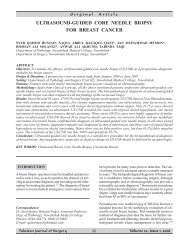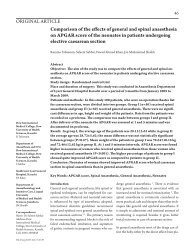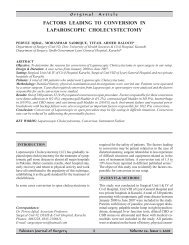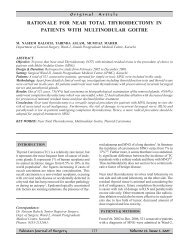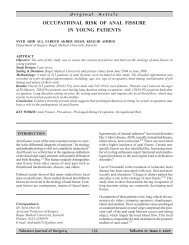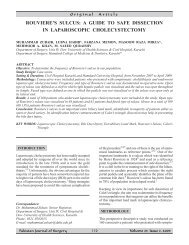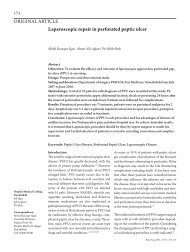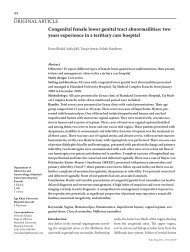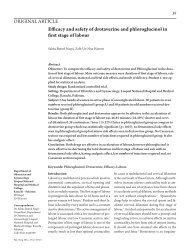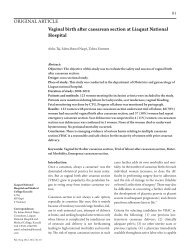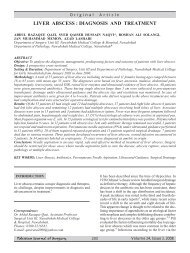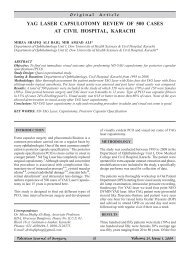Acquired Spontaneous Intercostal Hernia
Acquired Spontaneous Intercostal Hernia
Acquired Spontaneous Intercostal Hernia
Create successful ePaper yourself
Turn your PDF publications into a flip-book with our unique Google optimized e-Paper software.
Case<br />
Report<br />
ACQUIRED SPONTANEOUS INTERCOSTAL HERNIA<br />
ZAFARULLAH KHAN<br />
Department of Surgery, Bolan Medical College, Quetta<br />
ABSTRACT<br />
A case of acquired spontaneous intercostal hernia is being presented. The aetiology, clinical features, radiological<br />
findings and management are discussed.<br />
KEY WORDS: <strong>Hernia</strong>, <strong>Intercostal</strong> <strong>Hernia</strong>, Diaphragm, Mesh Repair<br />
INTRODUCTION<br />
<strong>Intercostal</strong> hernias are rare 1 . They are caused mainly<br />
by trauma and cough, resulting in weakening of intercostal<br />
muscles, detachment of the diaphragm and possibly<br />
a rib fracture 1,2 . The patient usually presents with<br />
a soft lump, which increases on coughing and straining.<br />
Diagnosis is confirmed with chest X-ray, ultrasonography<br />
and CT scan 3,4 . Treatment requires reduction of<br />
the hernial contents and repair of intercostal and diaphragmatic<br />
defects, possibly with prosthetic mesh reinforcement<br />
5,6 .<br />
wide clearly palpable defect between these ribs having<br />
sharply defined borders (Fig.1b). Bowel sounds were<br />
audible over the bulge. A clinical diagnosis of intercostal<br />
hernia was made. A chest x-ray and an ultrasound<br />
of the defect were inconclusive.<br />
Fig.1. Bulge of the <strong>Intercostal</strong> <strong>Hernia</strong> (a),<br />
with surface marking (b)<br />
CASE REPORT<br />
A 50 years old farmer presented with six months history<br />
of a spontaneously appearing and gradually increasing<br />
painless lump on the left side of his chest. It increased<br />
on coughing, straining at defecation and while working<br />
in the field but decreased on lying on the right side. He<br />
was a chronic smoker and had a long-standing cough<br />
that had increased over the past one year. There was no<br />
history of trauma.<br />
On examination, there was an oval bulge lying transversely<br />
between the 11th and 12th ribs on the left side<br />
of his chest, behind the posterior axillary line, having<br />
a positive cough impulse (Fig.1a). There was a 6cms<br />
Correspondence:<br />
Dr. Zafarullah Khan, Senior Registrar Surgery,<br />
Res: 168-I, Block-5, Satellite Town, Quetta.<br />
Phones: 081-2828841, 0333-7810516.<br />
E-mail: zafarkhanbabar@hotmail.com<br />
223<br />
Volume 23, Issue 3, 2007
<strong>Acquired</strong> <strong>Spontaneous</strong> <strong>Intercostal</strong> <strong>Hernia</strong><br />
Exploration was planned and an incision made over the<br />
defect in its long axis extending through the subcutaneous<br />
tissue. The muscle fibres over the hernial sac were<br />
found attenuated. These fibres were retracted and the<br />
hernial sac was dissected free from the sharp edges of<br />
the intercostal defect. There was no fracture of the ribs.<br />
The sac was opened and found to contain splenic flexure<br />
and adherent omentum. The diaphragm was found torn<br />
away from its costal attachment and had retracted creating<br />
a defect, through which splenic flexure and omentum<br />
had entered the pleural cavity and bulged posteriorily<br />
through the weakened intercostal muscles into the subcutaneous<br />
tissue. The omentum and the splenic flexure<br />
were reduced. The diaphragmatic defect was closed<br />
with horizontal mattress sutures of polypropylene. A<br />
chest tube was placed and the pleura closed. Approximation<br />
of ribs was not required. The intercostal defect<br />
was covered with a 6x11cms size polypropylene mesh<br />
and the wound was closed in layers. The patient made<br />
an uneventful recovery and was all right one year after<br />
surgery.<br />
DISCUSSION<br />
<strong>Intercostal</strong> hernia is a rare occurrence 1 . It can be congenital<br />
or acquired 7,8 . The latter can occur spontaneously<br />
due to local weakness of chest wall or increased intrathoracic<br />
pressure due to excessive coughing 1,5-7 . More<br />
commonly, it occurs following trauma, surgery or chronic<br />
pulmonary pathology.<br />
Trauma can be penetrating or blunt, resulting in fracture<br />
of ribs 3,9-15 . It can also occur as apart of the Seat-belt<br />
syndrome 16 . Reported surgical causes of the intercostal<br />
hernia include lumbar incision for the kidney, open lung<br />
biopsy, tube thoracostomy, rib resection, and harvesting<br />
of internal mammary artery 4,17-19 . Pathological conditions<br />
causing intercostal hernia include chronic cough<br />
due to chronic obstructive pulmonary disease, asthma,<br />
pulmonary hemosiderosis, pulmonary tuberculosis and<br />
caries of the ribs, empyema necessitans and chest wall<br />
abscess 1,6,18,20-22 . Miscellaneous causes include blowing<br />
of musical instruments, straining and weight lifting 22 .<br />
Formation of transdiaphragmatic intercostal hernia<br />
requires a chain of events 1,8,20-22 . Trauma denervates<br />
and weakens the intercostal muscles and the peripheral<br />
diaphragm supplied by these nerves. Rib fractures can<br />
tear intercostal muscles and the adjacent diaphragm.<br />
Chronic violent cough tears the intercostal muscles,<br />
detaches the adjacent insertion of the diaphragm and<br />
may even cause fracture of the overlying rib. Negative<br />
intrathoracic pressure draws the intra-abdominal viscera<br />
into the chest cavity where it eventually comes to<br />
rest in the space created by the torn muscles. Increased<br />
Zafarullah Khan<br />
intra-thoracic pressure causes herniation through weak<br />
areas of the chest wall. These areas occur anteriorily<br />
from costo-chondral junction to the sternum because<br />
of lack of external intercostal muscles and posteriorily<br />
from costal angle to the vertebra because of lack of internal<br />
intercostal muscles. <strong>Hernia</strong>l contents include<br />
lung, liver, small and large intestine and omentum.<br />
These viscera may undergo strangulation and require<br />
resection 1,6,17 .<br />
<strong>Intercostal</strong> hernia can occur from childhood to late adult<br />
hood 1,7,8,21,23 . It commonly presents as a slowly progressive<br />
swelling but acute herniation following vigorous<br />
coughing has been reported 1,6 . It can be painful as well<br />
as asymptomatic 3 . The contents can be ascertained by<br />
observing the size of the hernia during respiration 1 . The<br />
hernia containing lung has paradoxical movement and<br />
increases on Valsalva manoeuver. An increase in hernia<br />
size with inspiration and a decrease with expiration<br />
occurs when there is diaphragmatic injury with prolapse<br />
of abdominal viscera into the thorax and out<br />
through the chest wall 1,9 . It also increases on straining<br />
and reduces on lying down. Both an anterior and a posterior<br />
hernia may coexist 1 . Differential diagnosis includes<br />
lipoma, empyema necessitans and cold abscess 22 .<br />
On clinical examination the hernia appears as a bulge<br />
between two divergent ribs. It is soft and reducible and<br />
has a positive cough impulse. The defect in the chest<br />
wall is palpable having sharply demarcated borders.<br />
Bowel sounds may be audible over the bulge 1,4 .<br />
Chest X-ray, ultrasonography and CT scan can confirm<br />
the diagnosis of intercostal hernia 1-4,8,11,24 . Chest X-ray<br />
shows divergent ribs at the hernia site with bowel gas<br />
shadow beyond the confines of abdominal cavity. Ultrasonography<br />
detects deficient intercostal muscles. CT<br />
scan correctly identifies the hernia and its contents.<br />
Small hernias may be missed by these investigations.<br />
Helical CT is the investigation of choice for smaller<br />
hernias 6 .<br />
The treatment of intercostal hernia is mainly surgical<br />
but spontaneous regression has been reported 12 . Surgery<br />
is performed by making an incision over the hernia sac,<br />
which can be extended as a thoraco-abdominal incision<br />
if adhesions are present 1 . The sac formed by endothoracic<br />
fascia and parietal pleura is opened. The contents<br />
are reduced and the diaphragmatic defect is closed primarily<br />
or with a prosthetic mesh. Divergent ribs may<br />
require approximation. Raising periosteal flaps from<br />
adjacent ribs can be used to close the chest wall defect 22 .<br />
The intercostal muscles are attenuated and may require<br />
reinforcement by a prosthetic non-absorbable (polypropylene)<br />
mesh 1-4,11,22 .<br />
224<br />
Volume 23, Issue 3, 2007
<strong>Acquired</strong> <strong>Spontaneous</strong> <strong>Intercostal</strong> <strong>Hernia</strong><br />
REFERENCES<br />
1. Khan AS, Bakhshi GD, Khan AA, Kerkar PB, Chavan<br />
PR, Sarangi S. Transdiahragmatic <strong>Intercostal</strong><br />
hernia due to chronic cough. Ind J Gastroentrol<br />
2006; 25(2): 92-93.<br />
2. Cole FH Jr, Miller MP, Jones CV. 72 years old man<br />
with cough induced rib fracture, diaphragm tear,<br />
<strong>Intercostal</strong> hernia. Ann Thorac Surg 1986; 41:565-<br />
566.<br />
3. Serpell JW, Johnson WR. Traumatic diaphragmatic<br />
hernia presenting as an <strong>Intercostal</strong> hernia. J Trauma<br />
1994 March; 36(3): 421-3.<br />
4. Rosch R, Junge K, Conze J, Krones CJ. Incisional<br />
<strong>Intercostal</strong> hernia after a nephrectomy. <strong>Hernia</strong> 2006<br />
March; 10(1): 97-99.<br />
5. Aguero RJ, Ortiz CH, Elena JMI, Sanchez RC.<br />
<strong>Spontaneous</strong> <strong>Intercostal</strong> pulmonary hernia. Arch<br />
Broncopneumol 2000; 36: 354-356.<br />
6. Nielsen JS, Jurik AG. <strong>Spontaneous</strong> <strong>Intercostal</strong> hernia<br />
with subsegmental incarceration. European J Cardiothorac<br />
Surg 1989; 3: 562-564.<br />
7. Moncada R, Vade A, Gimenez C, Rosado W, Demos<br />
TC, Turbin R. Congenital and acquired lung hernias.<br />
J Thorac Imaging 1996; 11: 75-82.<br />
8. Tamburro F, Grassi R, Romano S Vecchio WD.<br />
<strong>Acquired</strong> spontaneous <strong>Intercostal</strong> hernia of the lung<br />
diagnosed on helical CT. Am J Radiol 2000; 174:<br />
876-877.<br />
9. Francis DM, Barnsley WC. <strong>Intercostal</strong> herniation<br />
of abdominal contents following a penetrating chest<br />
injury. Aust NZ J Surg 1979; 49: 357-358.<br />
10. Allen GS, Fischer RP. Traumatic lung herniation.<br />
Ann Thorac Surg 1997; 63: 1455-1456.<br />
11. Balkan ME, Kara M, Oktar GL. Transdiaphragmatic<br />
<strong>Intercostal</strong> hernia following a penetrating thorocoabdominal<br />
injury. Surg Today 2001 August; 31(8):<br />
708-711.<br />
Zafarullah Khan<br />
12. Saw EC, Yokoyama T, Lee BC, Sargent EN. <strong>Intercostal</strong><br />
pulmonary hernia. Arch Surg 1976; 111(5):<br />
548-551.<br />
13. Arslanian, et al. Post traumatic pulmonary hernia.<br />
J Thorac Cardiovasc Surg 2001; 122: 619-621.<br />
14. Rusca M, Carbognani P, Cattelani L, Tincani G.<br />
<strong>Spontaneous</strong> <strong>Intercostal</strong> pulmonary hernia. J Cardiovasc<br />
Surg (Torino) August 2000; 41(4): 641-642.<br />
15. Serpell JW, Johnson WR. Traumatic diaphragmatic<br />
hernia presenting as an <strong>Intercostal</strong> hernia. J Trauma<br />
1994; 38: 421-423.<br />
16. May AK, Chan B, Daniel TM, Young JS. Anterior<br />
lung herniation; Another aspect of the Seat belt syndrome.<br />
J Trauma 1995; 38: 587-589.<br />
17. Rompen JC, Zeebregts CJ, Prevo RL, Klaase JM.<br />
Incarcerated transdiaphragmatic <strong>Intercostal</strong> hernia.<br />
<strong>Hernia</strong> 2005 May; 9(2): 198-200.<br />
18. Ioachimescu OC, Jennings C. <strong>Intercostal</strong> lung cyst<br />
hernia in idiopathic pulmonary hemosiderosis. Mayo<br />
Clin Proc 2006; 81: 692.<br />
19. LaHei ER, Deal CW. <strong>Intercostal</strong> lung hernia subsequent<br />
to harvesting of the left internal mammary<br />
artery. Ann Thorac Surg 1995; 59: 1579-1580.<br />
20. Rogers FB, Leavitt BJ, Jensen PE. Traumatic transdiaphragmatic<br />
<strong>Intercostal</strong> hernia secondary to coughing.<br />
J Trauma 1996; 41: 902-903.<br />
21. Croce EJ, Mehta VA. <strong>Intercostal</strong> pleuroperitoneal<br />
hernia. J Thorac Cardiovasc Surg 1979; 77: 856-7.<br />
22. Bagga AS, Kakadkar UC, Lawande DJ, Chatterjee<br />
R. <strong>Hernia</strong>tion of lung. Ind J Tubercul 1995; 42: 47.<br />
23. Salter DG, Hopton DS. Traumatic <strong>Intercostal</strong> hernia<br />
without penetrating injury in child. Br J Surg 1969;<br />
56: 550-552.<br />
24. Bhalla M, Leitman BS, Forcade C, Stern E, Naidich<br />
DP. Lung hernia: Radiographic features. Am J Radiol<br />
1990; 154(1): 51-53.<br />
225<br />
Volume 23, Issue 3, 2007



